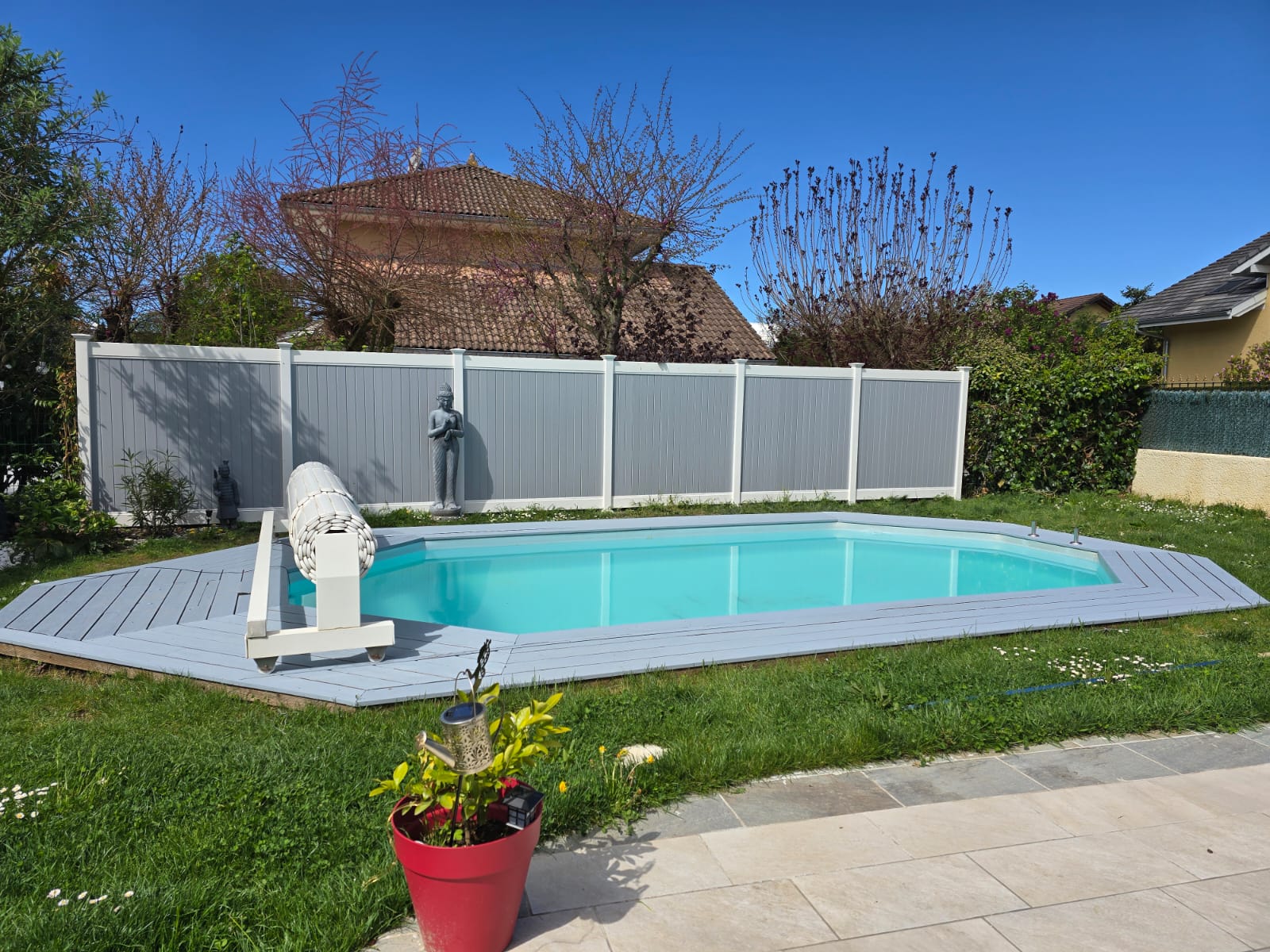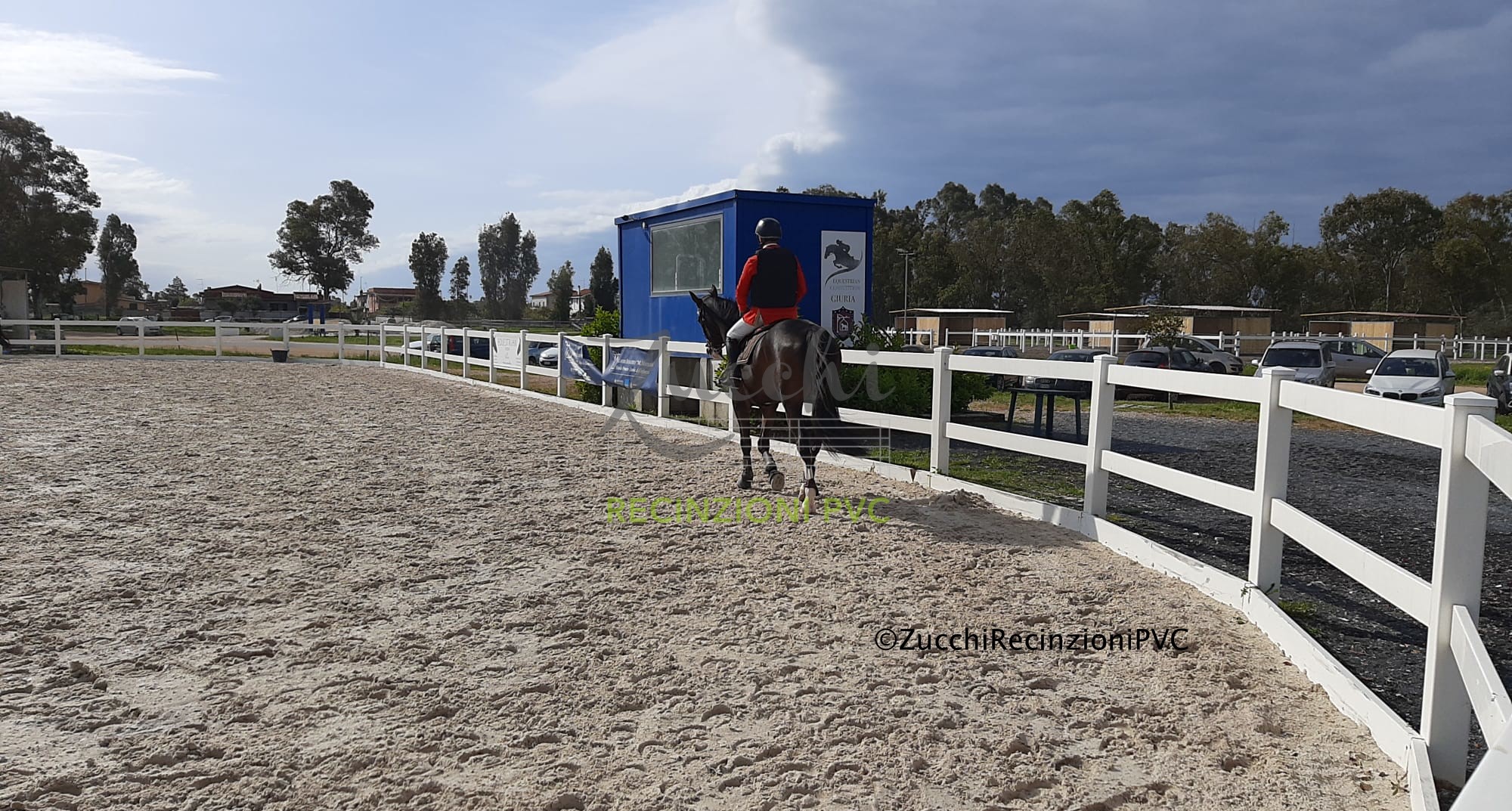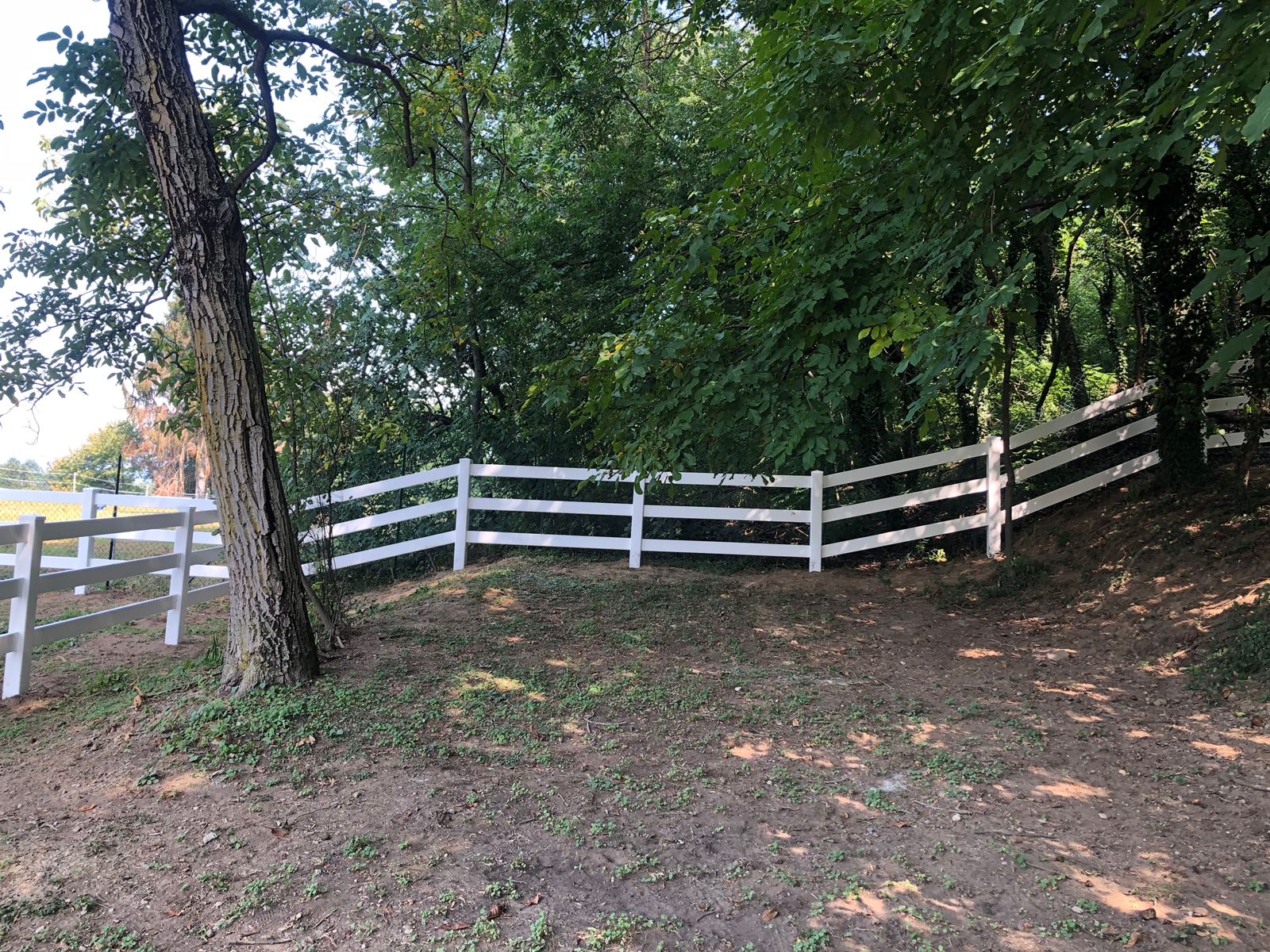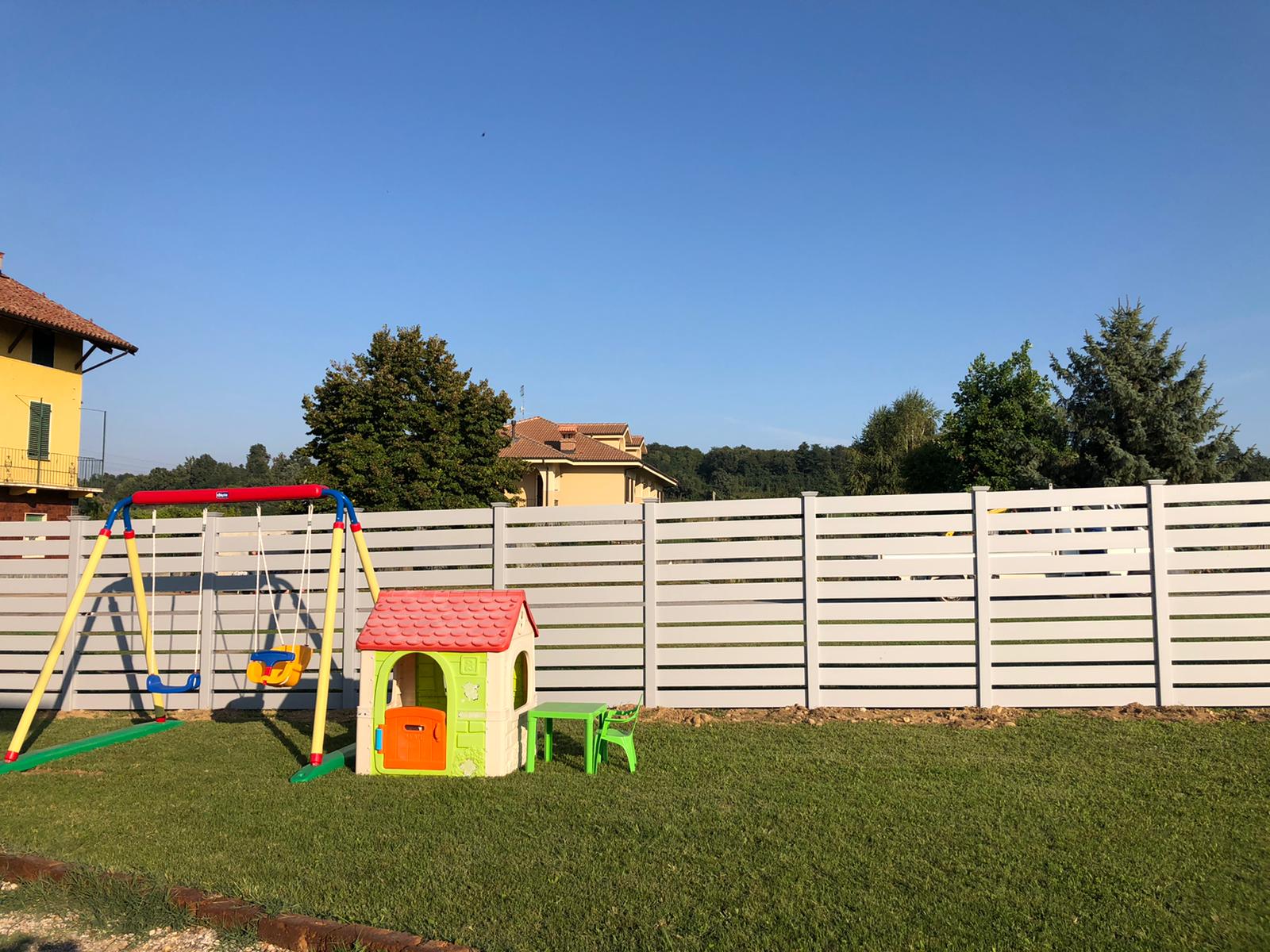Real houses, real inspirations: the fence that doesn’t disturb
When you think of a dream vacation home, you definitely picture sunshine, silence, a manicured garden and… a sparkling pool. But if your home is for rent, you already know that something else is also needed: security. That’s where the pool fence comes in, which today is no longer that bulky monster made of wrought iron or yellowed plastic.
Forget everything you saw in old campgrounds or homes with bunker-proof gardens: today there are solutions that are beautiful, lightweight and, hear hear, easily removable. Yes, you can have security without ruining the aesthetics of your outdoor space.
Let’s look together at some examples taken from real Italian and European vacation homes, where fences not only protect, but enhance the style of the garden.
Tuscany: rustic minimalism with transparent fencing
In a delightful stone house in Montepulciano, the pool is set in a meadow among olive trees and lavender. The risk? That a “classic” fence could break the magical atmosphere and spoil the view of the hills. The solution? A clear tempered glass fence with no visible frames.
It was chosen precisely to be virtually invisible. Guests can enjoy the environment without visual obstructions, and parents with young children immediately feel more relaxed.
The beauty is that this fence can be disassembled in two hours and stored in the garage for the winter months. No special tools required. Just a little patience, and voila: the pool is free again.
You can replicate this style even if your budget is smaller. In fact, there are modular panels made of transparent polycarbonate that mimic glass, but they cost much less and are even lighter.
Apulia: Mediterranean style with boho chic fencing
Puglia: Mediterranean style with boho chic fencingLet’s move on to Salento, where a white villa with soft lines houses a swimming pool framed by palm trees and dry stone walls. Here the owner’s goal was clear: make the garden Instagrammable to the max, but without compromising security.
The choice fell on a synthetic bamboo fence, with a metal frame covered with natural-effect reeds. A boho touch that blends perfectly with the outdoor furniture in rope and light wood.
The funny thing? Guests often mistake it for part of the furniture, so well it blends in. Yet, that barrier protects little guests and complies perfectly with regional regulations.
If you also aim for a Mediterranean style, you can find fences made of decorated technical fabric, or choose composite wood versions that mimic natural materials without rotting in the sun.
Lake Garda: Nordic elegance and removable panels
Another example comes from a modern villa overlooking Lake Garda. Here the style is much more minimal: clean lines, optical white walls, and a garden with artificial grass and potted plants.
In this case, the fence chosen is powder-coated aluminum, with thin light gray panels. The posts are almost invisible, and the modules can be repositioned according to the shape of the pool, thanks to an adjustable weight base.
The result? An elegant security perimeter that seems to be part of the original design of the house. No guests complain about its presence; in fact, many thank it for its attention to the safety of children and even dogs.
Want an extra tip? If you have a pool with an infinity edge or irregular shapes, opt for a flexible fence that fits without sacrificing design.
Use images to tell the story of your attention to detail
Have you ever thought that a beautiful photo of your fenced-in pool could become your secret weapon on Airbnb or Booking.com? An elegant, well-placed fence communicates care, attention and responsibility. In a world where reviews are everything, showing that you care about the safety of your guests can mean the difference between a lost reservation and a stay sold well in advance.
And it’s not just a matter of aesthetics: a properly fenced pool also conveys confidence to the portals’ algorithms. You may even get higher scores in search filters for families or groups with children.
A size for every pool (even yours)
Choosing the right pool fence is not only a matter of safety, but also of proportion and harmony. You know when a piece of furniture is too big for a room and looks bulky even though it is beautiful? The same goes for fences: they should protect without encroaching and follow the size of your space in a natural way.
If you manage a vacation home, you know that every detail counts: the pool is one of the highlights, and the fence needs to be there without standing out too much. Finding the right size is the first step to a functional and elegant result.
Whether you have a small backyard with a hot tub or a large space with an infinity pool, here’s what to consider before choosing your protective barrier.
Measure space–but also consider movement
First, get a tape measure (or a handy measuring app) and calculate the actual size of your pool, including at least a meter of margin around it. It’s not enough to just mark the edge-you also need to think about how guests will move, walk, run or lie near the water.
A fence that is too close to the pool can seem overwhelming and make even the simple act of stepping outside with a towel difficult. At the same time, leaving it too far away risks taking away useful space for relaxation or garden furniture.
Picture the scene: children playing, adults reading, friends toasting. Now ask yourself, “Where will people move? Where do I want the barrier between security and freedom to be?”
Small pool? Choose lightweight, modular fencing
Do you have a spa or in-ground pool designed for couples and families to relax? Great! The key word here is modularity. The best fences for small spaces are those with small, lightweight and easily repositionable panels, so you can adapt them to even the oddest corners of your garden.
Also, if your space is narrow, avoid materials that are too thick or visually cumbersome. A good idea is to use transparent netting or polycarbonate panels, which protect without blocking the view or taking away light.
And remember: in small spaces, every inch counts. That’s why it’s helpful to choose fences with freestanding bases that don’t require permanent holes in the ground. That way you can move them easily, depending on the season or garden use.
Large pool? Attention to distance and visual rhythm
If your pool is large and your backyard is large, you might consider installing a fence far back from the edges. This is an idea that works, but you must be careful not to create a hollow effect or make the pool look “isolated.”
The key here is visual rhythm: alternate full and empty spaces with a modular fence, perhaps with alternating panels or in natural materials that dialogue with the greenery around.
You also have more freedom in terms of height: you can use taller fences for added protection, but make sure the whole thing doesn’t look like a zoo enclosure! Keep the balance with the context: a modern villa requires clean lines, while a rustic house can accommodate wood or wrought iron details.
And an extra idea: consider including a stylish gate as an entry point. Besides being useful, it gives structure to the entire perimeter.
Choose based on the type of guest, not just the pool
Don’t forget that those who will use the pool will not always be the same person. A family with children will have different needs than a couple seeking relaxation. That is why versatility in size is important.
If you rent your home to different guests each week, consider a fence that can expand or shrink easily, such as a telescoping or interlocking system. That way you can adapt it to the type of clientele and conditions of the moment, even for events or large groups.
Guest reviews often talk about feelings, not just measurements: if they feel protected but free, they will leave better feedback.
Because neutral is anything but boring
When it comes to pool enclosures, especially in a vacation home, color is more important than you imagine. It’s not just about personal taste, but about creating an environment that is welcoming, stylish and easily appreciated by all. That’s why neutral colors have been the real stars of the choices of discerning hosts for years.
You want your pool to be beautiful, safe and relaxing, right? Here, choosing a neutral color helps you with just that: it doesn’t disturb the view, fits any style, and appeals to virtually everyone.
Gray, beige, sand, off-white, taupe–these names might sound like something out of a furniture catalog, and indeed they are. Because by now even a fence needs style and visual consistency with its surroundings. And the good news? You don’t need to be an architect to make the right choice.
The color that blends with the environment (without disappearing)
Imagine this scene: a beautiful swimming pool with a natural stone edge, manicured green lawn, and light wood loungers. Now imagine a red fence. Yes, really red. It’s an eyesore, isn’t it?
This is why the right color is often one that blends in but does not disappear. Neutral colors such as taupe, pearl gray, or sand blend perfectly into both modern gardens and rustic settings without drawing too much attention, but without disappearing into thin air.
A good neutral color has an understated personality: it accompanies the eye, not forces it. It helps the eye focus on what really matters-the pool, the nature around it, the relaxing atmosphere-and not on the protective structure.
If you choose a light or intermediate tone, you will also make guests who like to take photos happy, because neutral colors look good in any shot, especially with the sun reflecting off the water.
Neutral yes, but with character: how to choose the right shade
Not all neutrals are the same. Although they may seem similar at first glance, each shade has a different impact on the environment. Here are some simple tips for choosing well.
- Light gray: perfect for modern homes, pools with stone or concrete edges, outdoor furniture made of metal or glass.
- Beige or sand: ideal for rustic settings, terracotta or wooden floors, vacation homes surrounded by nature.
- Turtledove: a wild card! It works great in both modern and classic settings, and is also widely used in hotels and resorts.
- Opaque white: great for those who want a super clean effect, but be careful not to overdo it in very sunny areas-it may reflect too much.
- Soft black or anthracite: less “neutral,” but still understated. Perfect for rooms with an industrial flavor or for fences with glass.
The trick is to think about the palette of your vacation home as a whole. If you already have lots of bright colors in your garden or furniture, a balanced neutral can make the perfect backdrop.
The trick is to think about the palette of your vacation home as a whole. If you already have lots of bright colors in your garden or decor, a balanced neutral can make the perfect backdrop.More neutral, less stress (also for reviews)
Do you know one of the main reasons hosts choose neutral colors for pool fences? To minimize the risk of criticism from guests. Yes, because every taste is different, but neutral colors get almost everyone to agree.
An orange fence might look original, sure. But are you sure it will appeal to someone from Milan, a Dutch couple, or an English family? Neutral is universal, doesn’t go out of style and, most importantly, doesn’t distract from the experience.
What’s more, an understated color communicates seriousness, order and security, all of which are key to making guests feel calm and welcome. And that translates into better online reviews, fewer problems and more bookings.
Plus, let’s face it, it’s also easier to manage. Neutrals resist visual dirt, the passage of time and trends better. You won’t have to change fences every summer just to follow fashion.
Assemble it yourself: satisfaction guaranteed (if you have time and patience)
If you are the type of person who likes to tinker with a drill and read instructions before you start, then do-it-yourself assembly may be just the thing for you. In fact, the latest generation of removable pool fences are designed to be assembled without professional equipment, and they often arrive with complete kits and simplified instructions.
The big advantage of do-it-yourself is that you save on labor, and you can decide your own time, schedule, and methods. No waiting for the plumber or the technician who stands you up at the last minute. You arrange it the way you want, maybe on a nice sunny day, and you even enjoy some personal satisfaction.
However, you need to be honest: it’s not all sunshine and roses. If you are not very handy with tools, or have never assembled anything like this, you may find yourself wasting more time than expected. And if you get something wrong when fixing or aligning, you risk compromising the safety of the structure.
In summary. DIY assembly is perfect if:
- You like to do small crafts.
- You want to save costs.
- You have free time to yourself before guests arrive.
- You have a simple space with no strange curves or complicated height differences.
Professional installation: no worries, everything perfect
If, on the other hand, you are the type who prefers to say, “Let someone who can do it better than me do it,” then relying on a professional installer is probably the most relaxing choice. In this case, you just pick the fence, set the date, and open the door. They do the rest.
The biggest advantage? Zero stress. A good technician knows exactly where to place the panels, how to adapt them to the ground, how to ensure maximum stability and comply with all safety regulations.
Also, if your vacation home has an irregularly designed pool, or a garden with tricky corners or mixed surfaces (pavement + lawn), having someone who knows the tricks of the trade saves you from costly mistakes.
The downside, of course, is the extra cost. Depending on the area and the type of fencing, you could spend as much as twice as much as do-it-yourself. But for many hosts it’s an investment worth making, especially if you want a clean, fast and guaranteed job.
Professional assembly is recommended if:
- You have little time or don’t like manual labor.
- You want a guarantee on the end result.
- You have a pool with a complex shape or small space.
- You want to avoid any margin for error and sleep soundly.
What if you choose–a mix of the two?
Yes, there is also a third way: do one part on your own and one part with the help of an expert. Some suppliers offer an online or telephone consulting service, where they guide you step by step and help you avoid common mistakes. Alternatively, you can assemble the main panels yourself and leave the trickier final part, such as fixing the gate or uneven corners, to a technician.
It is a choice that more and more hosts are adopting because it saves money without sacrificing quality. It also allows you to get to know the structure of your fence better, so you can easily take it down out of season or move it in case of events.
This option is ideal if:
- You are averagely practical but prefer to have guidance.
- You want to save some money but not risk too much.
- You only need to customize certain sections of the perimeter.
- You also want to learn how to manage the fence on your own.
Conclusion: what is the best choice for you?
The truth is that there is no right choice for everyone, only the right choice for you. If you are a dynamic host with good manual dexterity and a simple pool, do-it-yourself might be your chance to get your hands on the dough and save some money.
If, on the other hand, you prefer peace of mind, or you already have too many things to handle for the apartment, better to delegate the assembly and invest in the quality of the result. Your guests will immediately notice the difference.
And then there is the middle ground, for those who want to learn but with a safety net.
Whichever route you choose, always remember that the important thing is to ensure safety, beauty and compliance. Because a well-installed fence not only protects, it speaks of you as a caring, professional and detail-oriented host.







Leave A Comment